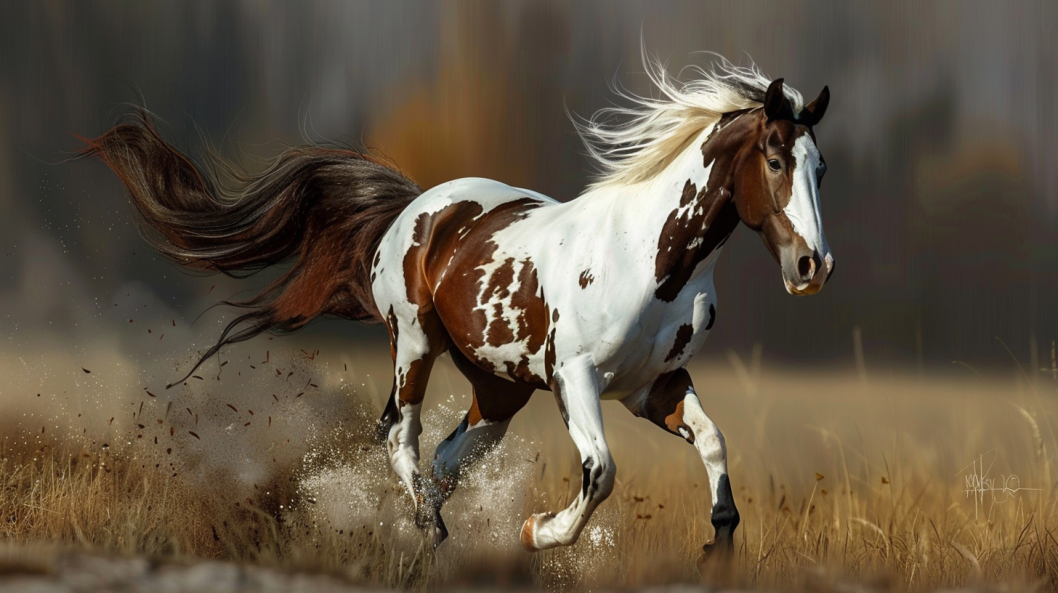Beautiful horses with a unique pattern that combines white and black, chestnut, or bay? That’ll be an American Paint horse. Their gracefulness and distinctive markings set them apart from other breeds and are favorites among many people. The American Paint Horse is a unique and vibrant breed known for its striking coat patterns and gentle temperament. But there is much more to these majestic animals than just their looks. Their intelligence, versatility, and friendly nature make them remarkable and beloved companions. This breed combines the speed and agility of the Quarter Horse with the distinctive coloration of the Paint.
Paint Horses are admired for their beauty and versatility. I’ve worked with Bella, a striking chestnut and white Paint Horse known for her gentle demeanor and intelligence. Bella excels in trail riding and arena work, demonstrating agility and sure-footedness. What I value most about American Paint Horses like Bella is their capacity to form strong bonds with their riders, creating rewarding experiences based on trust and partnership. In this article, we will share the origin and features of this breed and the traits that make them endearing and unique. But first, here’s a quick overview of what a Paint horse is like.
An Overview of Paint Horse Breeds
Paint horses are famous due to their ostentatious coat patterns and docile temperament. Thankfully, these beautiful creatures are still thriving today. According to the American Paint Horse Association, there are about 100,000 members from 40 countries worldwide. They are suitable for owners and riders from all levels, and they can compete in any equestrian sport, work on farms, and give a joyful ride. Here’s a look at their physique and features.
Average Weight: 950 to 1,200 pounds
Average Height: Between 14 hands high (56 inches) and 16 hands high (64 inches)
Physique: Strong and balanced body with powerful hindquarters and beautiful coat patterns
Suitable for: Horse lovers and riders of any age and level, including aspirant racers and those who seek a friendly companion.
Life expectancy: 30-31 years
History and Origin of Paint Horses
Paint horses trace back to the Spotted Oriental horses from Eurasia to Spain around 500 A.D. They were bred with the native horses in Spain. Records in 700 A.D. reveal that there were spotted horses with overo and tobiano patterns at the time that are similar to the American Paint Horses today.
Experts believe that the descendants of American Paint horses were brought to North America by Spanish explorers, particularly Hernando Cortes, in the 1500s. He brought a total of 16 war horses to the continent, and one of them was a sorrel and a white pinto. It started more paint breeding and made its way across Western countries. Today, the American Paint Horse Association keeps the breed’s registry, which includes 800,00 paints.
Color Patterns in Paint Horses
The distinctive patterns of American Paint Horses can be a combination of white and other colors of the equine spectrum, including black, bay, chestnut, dun, palomino, and more. They come in various shapes and colors. These are the three main coat patterns of Paint Horses:
Tobiano
In this pattern, the base color is located at the flanks while the white patches are on the withers and tail, and the head has a solid color with few markings like stars, blazes, and strips. Horses with this pattern have distinct spots with clear borders, and their mane hair and tails can have two colors.
Overo
Horses with Overo patterns have irregular patches around their body, but their backs are usually in solid color. Their face is generally white, and their legs are colored, but they can sometimes have white stockings.
Tovero
Tovero is a combination of Tobiano and Overo. Therefore, it exhibits the characteristics of the two. They might have basic tobiano coloring with blue eyes or a white coat on the body with base colors on the muzzle, ears, chest, and flank areas.
Breeding and Common Uses
Paint Horses were bred to create and preserve their unique coat patterns and good qualities such as friendly and calm demeanor and athleticism. They were mainly used for transportation and work due to their incredible strength, speed, agility, and stamina.
Aside from competing in multiple equine sports and activities, Paint horses love riding on trails and pleasing their owners and riders. They are multi-talented equines who can easily do any task, including racing, jumping, dressage, and challenging work.
Traits and Characteristics of Paint Horses
The most distinctive feature of Paint horses is their color, patterns, and markings. But they are more than just a beauty. They are also friendly, calm, innately intelligent, and easygoing, so they are easy to train. They are the perfect blend of beauty and competitive spirit of athleticism.
Common Health and Behavioral Problems
Most Paint horses are easygoing and have no significant behavioral issues. However, they are prone to some genetic diseases.
One of the genetic diseases that affect Paint horses is Lethal White Syndrome. Some horses can become carriers without health issues, but foals with two copies of the defective gene may be born with a white coat, blue eyes, and undeveloped intestines – making them prone to colic. There’s no available treatment for the disorder, so foals only last for a few days and eventually die.
Some paints may also suffer from hyperkalemic periodic paralysis – a hereditary disease that causes muscle twitching and weakness. Others are at risk of inheriting a tissue disorder called Hereditary Equine Regional Dermal Asthenia (HERDA).
Paint Horses are renowned for their eye-catching looks, characterized by their distinctive coat patterns of white and dark patches that make them visually stunning. Beyond their striking appearance, they are also celebrated for their friendly and adaptable nature, which makes them excellent companions for riders of all experience levels. Their easygoing temperament and willingness to work contribute to their popularity in various equestrian disciplines, from pleasure riding to competitive events.





